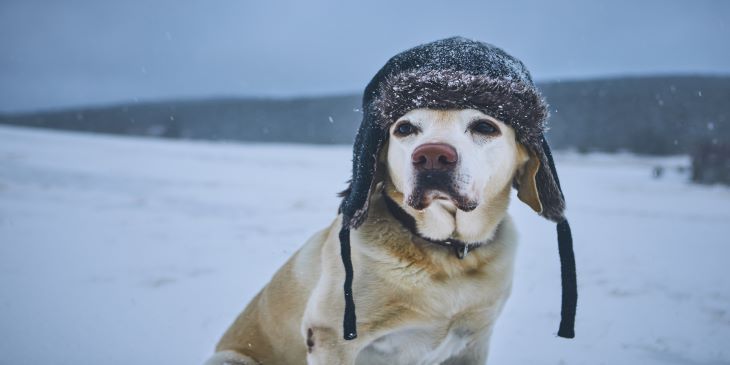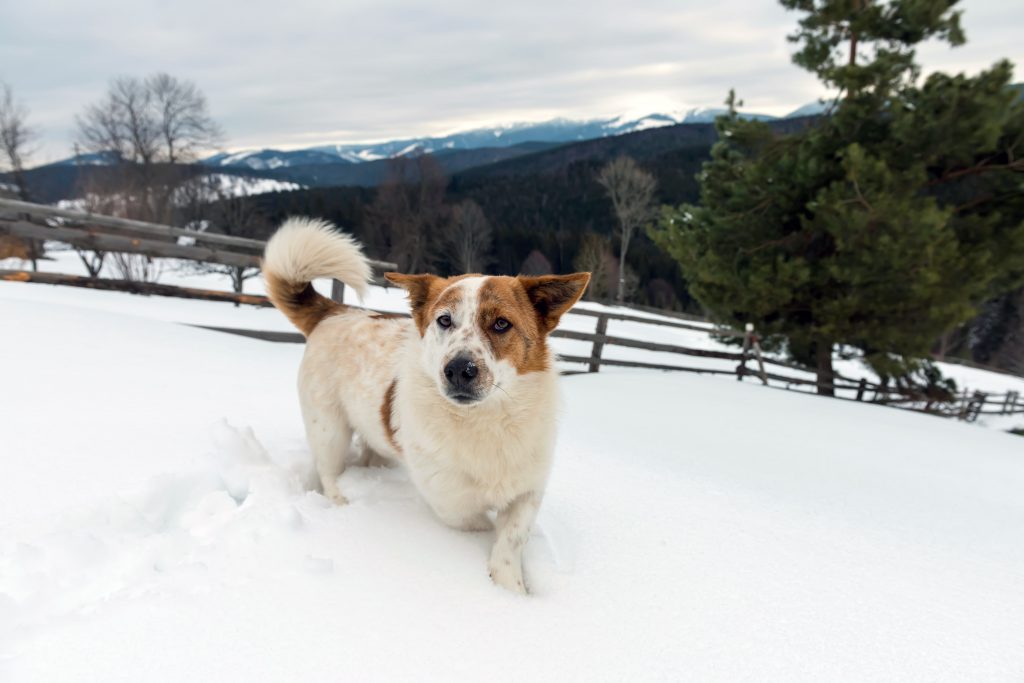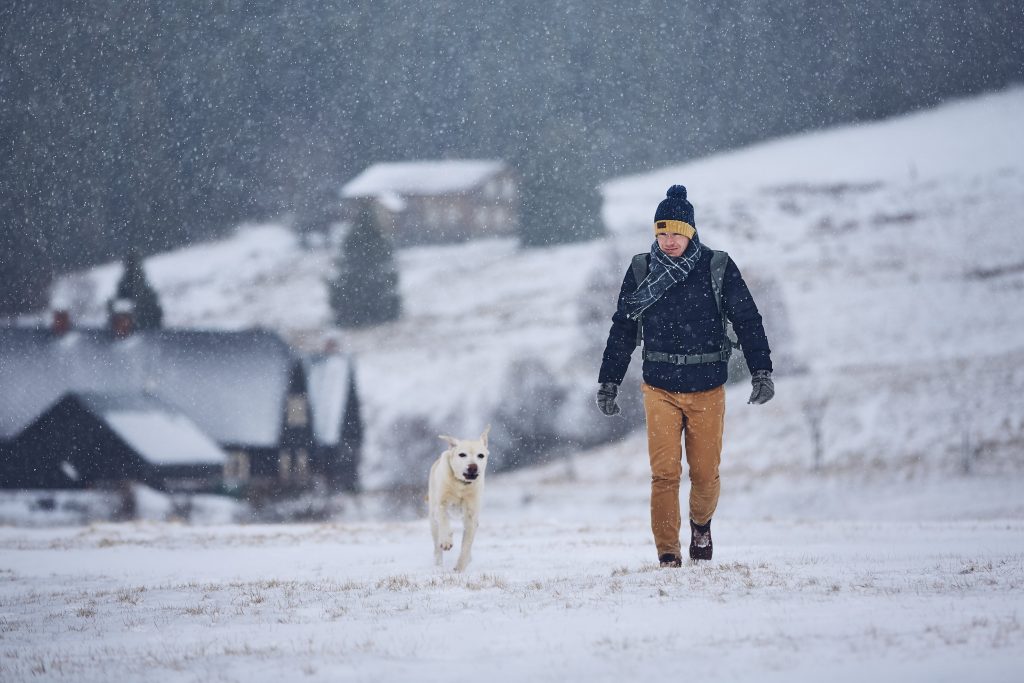15 Ways to Protect Your Dog When It’s Cold Outside

Contents
Dogs are a lot like people. Some of them love the snow and cold weather. Others would rather cuddle up on the couch and hibernate until spring. Either way, it’s our job as pet parents to keep them safe when they venture outside in the winter weather.
Although many humans think that dogs can tolerate the cold better than people because they have a fur coat, that’s not always the case. Our domesticated dogs have become used to the warmth an indoor shelter provides, and cold weather can be just as dangerous for them as it is for us.
The fact is, our furry family members need a little extra care when the weather turns cold. Here are 15 dog care tips for winter to keep in mind as you head outdoors for adventures in the snow.

Winter Health Risks for Dogs
Before we dive into our best winter dog care tips, let’s talk about the two health risks you should be most concerned about in cold, snowy weather.
· Hypothermia
Dogs are at risk of hypothermia in the wet and cold, just like humans. Dogs who are older or are in poor health can develop this condition quickly. Even healthy dogs that stay outside in the cold for too long or get wet when it’s cold out without the opportunity to dry off and warm up are at risk.
Mild cases of hypothermia in dogs present as shivering with cold ears and feet. As the condition worsens, the dog will show signs of weakness, become lethargic, and will seem depressed. Eventually, the animal’s heart rate and respiration slow down, its muscles become stiff, and it will become unresponsive.
If you suspect that your dog has even mild hypothermia, get him to a warm location immediately. If the condition has progressed, do everything you can to get the dog warm and head directly for the closest vet. Severe hypothermia can be fatal, so don’t take any chances.
· Frostbite
Once an animal’s body gets too cold, he’s susceptible to frostbite. Natural survival instinct tells the dog’s circulatory system to pull blood from his extremities and direct it to the center of the body where his life-sustaining organs are.
Unfortunately, frostbite in dogs can easily go unnoticed until it’s too late. The dog’s tail, paws, and ears can become so cold that ice crystals begin to form inside the tissues, causing severe and sometimes permanent damage.
When you are out with your dog in cold weather, watch for signs of pale or greying skin, or skin that’s turning cold and hard. If you notice any of these signs, get your dog indoors and warmed up immediately.
As you can imagine, the frostbitten areas will cause extreme pain as they warm up. Severely frostbitten skin will turn black and eventually slough off. If you suspect your dog has frostbite, get him warm and contact your vet right away for advice.

15 Dog Care Tips for Winter
How do you know if it’s too cold outside for your dog? It’s actually pretty simple. If it’s too cold for you to step out the door without your coat on, it’s probably too cold for your pooch also.
For more insight, pay close attention to how he acts when you’re outdoors in the cold. If you notice that your dog is shivering, whining, appears anxious, or doesn’t want to play anymore, it’s time to head back in the house.
Let’s dive a little deeper into our top dog care tips for winter.
1. How Cold is Too Cold?
How cold is too cold for your dog? If your dog is shivering, it’s too cold. Some dog breeds have thick coats that help them stay warm in the cold, so they can do fine for a little while outside even when it’s very cold.
But other breeds with short or thin coats may need a coat or sweater to protect them from the cold, even on short walks. Be sure to get a coat that reaches all the way from the base of the neck to the base of the tail and look for one that protects the chest and belly.
Keep in mind that ears, feet, and tails will still be prone to frostbite in either case. Err on the side of caution and take him in if you’re concerned.
2. Take Your Long Walks When It’s Warmer Out.
If your dog gets cold quickly, take your long walks in the early afternoon when the sun is out, and it’s a little warmer. This is also the best time to play some fetch or a little hide and seek in the back yard. Remember, dogs need exercise and sunshine even in the winter.
3. Keep Your Outdoor Excursions Short.
Even the furriest dog gets cold, even if he doesn’t act like he is. When the temperatures are frigid, keep your walk and outdoor playtime short.
Don’t leave him out in the yard for too long, even if he seems like he’s enjoying it. Remember, the signs of frostbite aren’t evident until it’s too late, so when you’re ready to go in, take your dog in also.
4. Choose the Right Winter Bedding for Your Dog.
Your dog won’t enjoy sleeping on a cold floor in the wintertime. And if he’s older, the cold will make him stiff and sore.
Warm blankets and raised beds are a great winter bedding option for dogs. If your older pooch is especially bothered by the cold, consider a heated pet bed or pad to keep stiffness away.
Make sure his bed isn’t in a drafty area, too. If you can, put it in one of his favorite sleeping spots so he’ll be more likely to use it.
5. Be Cautious About Heat Sources.
Dogs will seek out the warmest place in your house during cold weather. Make sure they don’t snuggle up too close to space heaters and radiators, so they don’t end up getting burned. Fireplaces are also a significant concern, so be sure yours is dog-proofed to keep your heat-seeking pooch safe.
6. Prevent Dry, Flaky Winter Skin.
Dry, cold air can do a number on your dog’s skin. Adding an omega-3 fish oil supplement to your pup’s food each day helps prevent dry, flaky skin and provides numerous other benefits.
7. Be Cautious of Overfeeding.
It’s easy to put on a few pounds of the winter when you can’t be as active, not just for humans, but for dogs too. Make sure your dog’s extra layer of warmth comes from a sweater, not a layer of fat.
Pay attention to your pup’s activity level, and adjust the amount of food you give him accordingly. Choose a high-quality diet to keep his skin healthy and energy levels up during the cold weather.
8. Water is Still Important.
Your dog may not drink as much water in the winter, but it’s still important to make sure he has plenty of fresh, clean water available at all times, so he doesn’t become dehydrated.
9. Grooming Your Dog in Winter.
Your dog’s coat should be brushed and clean throughout the winter to keep him properly insulated. It’s ok to give him a bath too, just be sure he’s completely dry before you let him go outside.
10. Paw Care is Extra Important in Cold Weather.
Just like our hands and feet can crack in the cold, the paw pads on your dog’s feet can dry out and crack, too. If the bottoms of your dog’s feet are furry, keep the hair between his pads neatly trimmed to prevent snow and ice from collecting on the bottoms of his feet.
Salt used to melt ice on sidewalks can burn our dog’s paw pads, and it’s also toxic. Be sure to wipe or rinse his feet off when you come inside if you’ve been walking in an area where salt is used.
If your dog seems especially bothered by walking on cold sidewalks and other surfaces, consider investing in a pair of doggie booties to protect his feet in winter.
11. Be Aware of Piled Up Snow.
A lot of dogs enjoy the snow, but it can present some dangers you should be aware of. For example, if the snow gets piled up near a fence, it could become an escape route without you realizing it. Be sure to place snow piles far away from fences to ensure your dog can’t climb out and get lost.
Snow and ice that accumulates on rooftops will melt rapidly when the sun comes out. As it slides off, it could injure you or our dog. If you’re not able to keep your roof clear, make sure your dog isn’t near the overhang to prevent injury.
12. Be Cautious of Frozen Water Sources.
Taking your dog on hikes in new places can be so much fun, even in the wintertime. But if you’re walking in an unfamiliar area, keep your dog close and be on the lookout for frozen streams, ponds, and lakes. They may not be readily visible if they’re covered in snow, and they present a serious danger for you and your dog if they’re not entirely frozen.
13. Antifreeze is Extremely Dangerous for Dogs.
Antifreeze is a necessity if you have a car in cold weather. However, antifreeze is hazardous for dogs, and ingesting even a small amount can be fatal.
To make matters worse, it tastes sweet, so dogs, cats, and even some children will drink or lick it readily. Keep your pets off the driveway and out of the garage or any other areas where he might be able to get into antifreeze.
14. Don’t Leave Your Dog Unattended in the Car.
Never leave your dog alone in the car during any season. Freezing cold temperatures are just as dangerous for dogs as hot temperatures are in the summer.
Leaving the car running is a bad idea, too, because of the risk of carbon monoxide build-up inside the vehicle. And, pet theft is becoming more and more uncommon. Dog’s left alone in the car are an easy target for dognappers.
15. Senior Dogs Require Special Care in Winter.
Cold, wet weather can aggravate existing health issues in senior dogs, especially joint problems like arthritis. Keeping an arthritic dog active is essential, but be careful of slippery or icy surfaces.
Be sure to provide a soft, warm place for him to rest after he’s been outside. If he isn’t already on a joint supplement, be sure to add one during the winter months.
Conclusion
There’s no reason to make your dog stay indoors all winter, but keep these winter dog care tips in mind as the cold weather sets in. As a pet parent, it’s up to you to protect your dog when it’s cold outside, but you can still have fun if you take the proper precautions. And, don’t forget, wintertime snuggles on the couch are the perfect way to stay warm and dry on those especially cold, nasty days.
